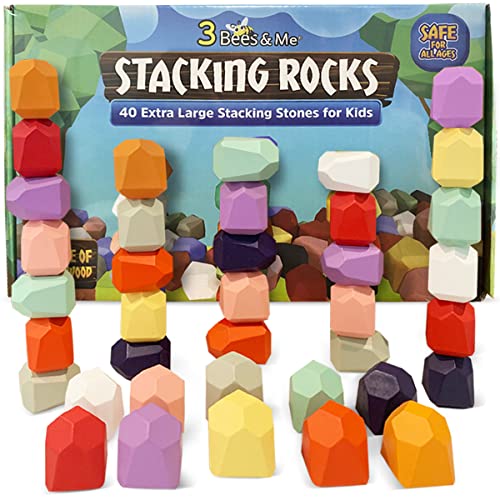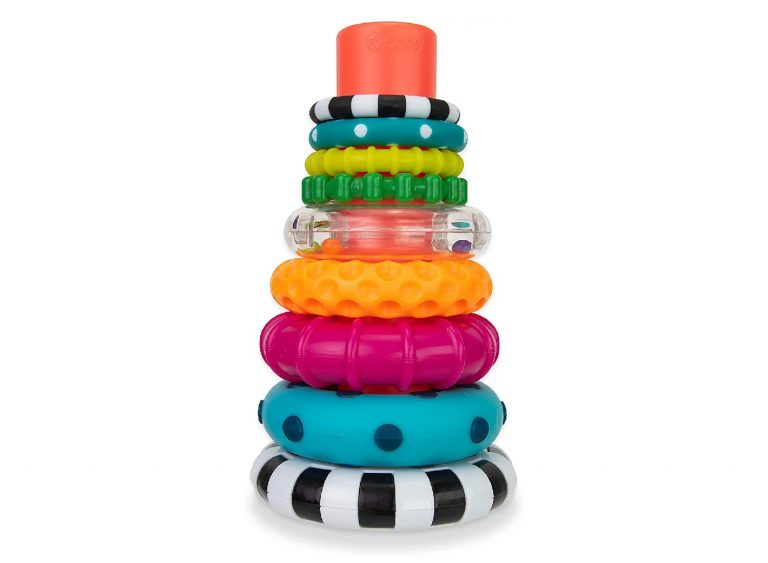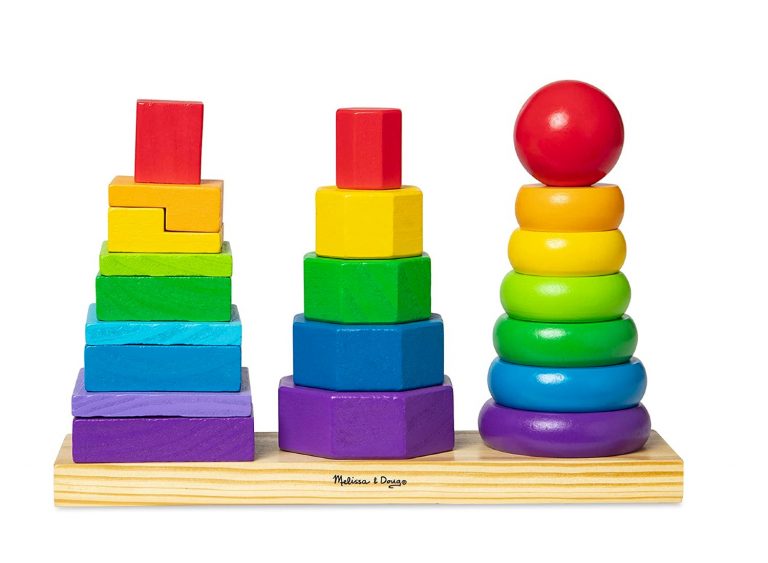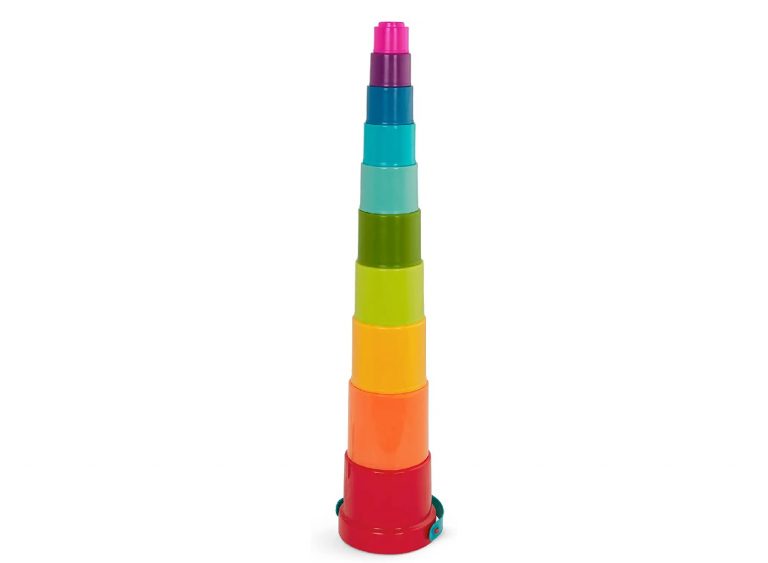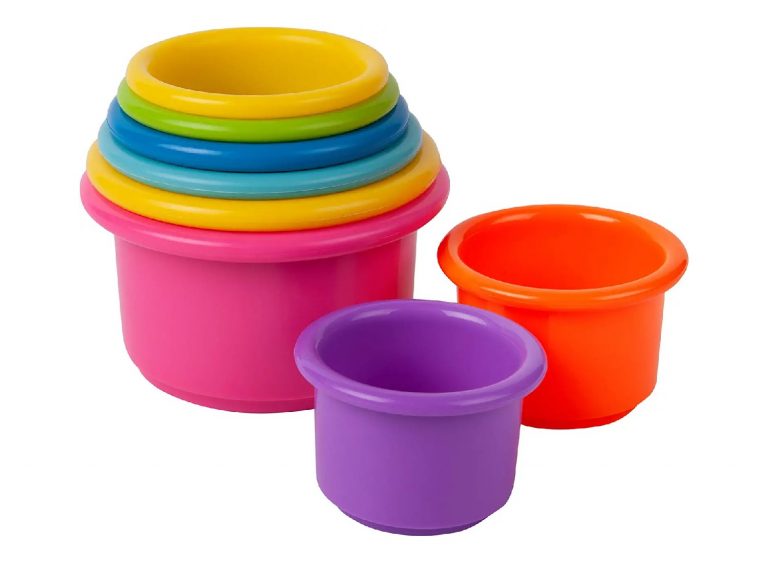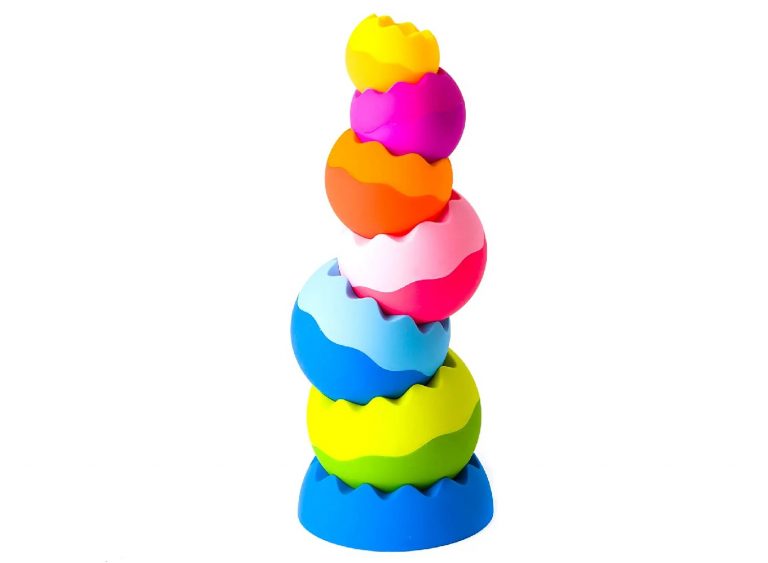The Best Stacking Toys of 2024
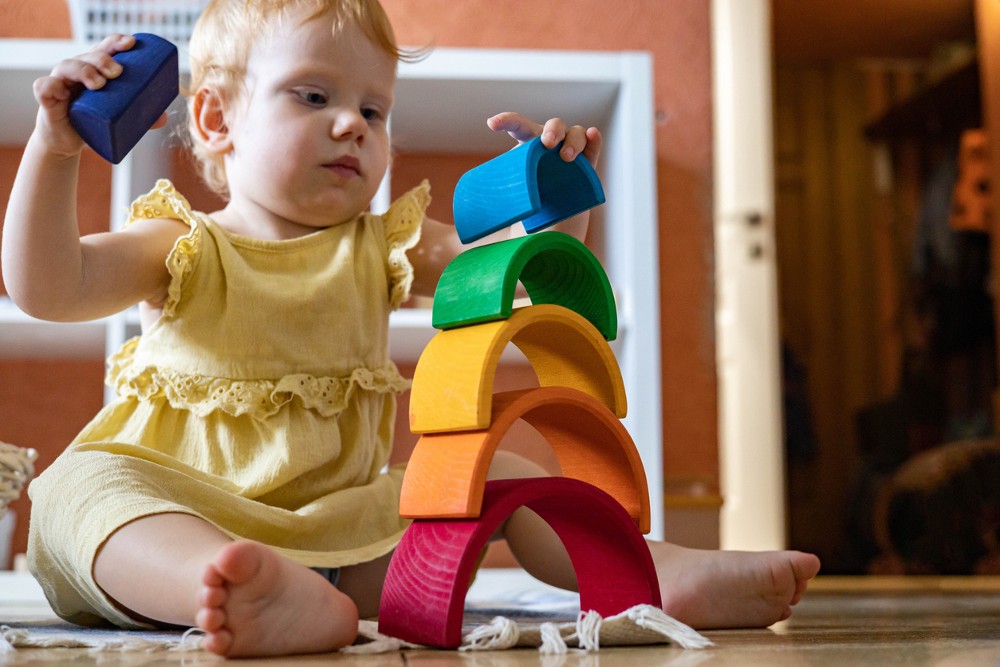
Did you know stacking toys can help boost your child’s motor skills and eye-hand coordination during their playtime? But that’s not all. These toys also improve your child’s cognitive skills like problem-solving, color recognition, and size sequencing. So, if you’re looking to improve your child’s developmental skills without forcing them to do brain activities, consider getting a set of stacking toys.
But with so many types of nesting toys available on the market and with so many toys designed for different purposes, finding the right one for your kid can be tough. In this article, we’ll go over the most effective stacking toys of 2024. Plus, we’ve included a detailed buying guide to answer all your questions about these clever toys. Let’s take a look!
Our Top Picks
- 3 Bees & Me Wooden Stacking Rocks for Kids: Best Overall (shop now)Read more about this ↓
- Sassy Stacking Toys: Runner Up (shop now)Read more about this ↓
- Melissa & Doug Stacking Toys: Versatile Pick (shop now)Read more about this ↓
- Battat Stacking Toys: Best for Older Kids (shop now)Read more about this ↓
- The First Years Stacking Toys: Most Durable (shop now)Read more about this ↓
- Fat Brain Toys Stacking Toys: Best Design (shop now)Read more about this ↓
Buying Guide: Stacking Toys
Stacking toys come in all shapes and sizes, which may make it hard to decide on the right one for your toddler. This buying guide will give you all the essential information you need to know regarding stacking toys to help you pick the most suitable and effective toy set for your child.
What Are the Benefits of Stacking Toys?
Motor skills
Stacking toys require a kid to frequently move their body to mount one piece on top of another. While your kid can stack toys while sitting, they may also need to stand up to nest the higher parts. This helps your child stabilize their core and improve their fine and gross motor skills. As a result, they become more agile and can walk and crawl faster.
Eye-hand coordination
Nesting toys within each other requires kids to move their hands according to their sight. This helps them develop better eye-hand coordination so they can process visual input faster and more accurately. Better eye-hand coordination also helps children with performing activities like writing, drawing, typing, and catching a ball.
Spatial reasoning
Spatial reasoning refers to the ability to understand and remember spatial and visual relations between shapes. In other words, it helps to connect math to the physical world. Stacking toys come in different shapes and require kids to reason and remember their shapes and sizes, leading to better spatial reasoning and problem-solving skills.
Imaginative thinking
Stacking toys include a variety of nesting possibilities and combinations. This allows your child to broaden their minds to thinking in new ways. The development of creative thinking teaches children to deal with everyday problems, which helps them perform better at life.
What Are the Types of Stacking Toys?
Rings
Ring-based nesting toys are essentially rings of varying sizes. Their base contains a stick to hold them steady and allow for frustration-free stackability. Ring-based stacking toys are most suitable for younger kids as they’re easy to stack on top of each other and require minimal reasoning.
Geometric shapes
Many nesting toys come in geometric shapes like rectangles, squares, triangles, octagons, hexagons, and spheres. These stacking toys are a better fit for kids between 12 months and 18 months of age as they help your child develop shape recognition skills. Geometric nesting toys tend to be versatile and more interesting for kids. Plus, they hone your child’s spatial reasoning skills.
Cups
Cup nesting toys are generally easy to play with and require minimal space. They’re essentially cups of different sizes that can be stacked on top of one another. Cup-based stacking toys tend to contain alphabets or numbers on their sides to improve your toddler’s number or letter recognition skills. In most instances, the numbers appear when the cups are invertedly stacked.
Objects
Some nesting sets contain unique objects or random shapes that form a specific object when piled up, like a house, a giraffe, or a tree. Such stacking toys are the hardest to play with and spark the most amount of creativity and imagination in your child. Because they’re tough to stack correctly, these toys are ideal for older children who are over 24 months old. These stacking toys are also great at keeping curious kids busy as they try to figure out the right stacking order.
Things To Consider When Choosing a Stacking Toy
Learning features
Stacking toys include a variety of different learning features other than problem-solving and eye-hand coordination. Some of them have printed numbers or letters so your child can practice saying the alphabet or counting.
Other toys come in multiple colors to help your child with color recognition. Some stacking toys have different shapes to teach your child basic geometry. So, when looking for a stacking toy, make sure it has the learning features you’d like for your child.
Difficulty level
Some stacking toys are fairly easy to stack on top of one another while others require more creativity and problem-solving. Stickless nesting toys, for example, are harder to play with as they lack a balancing stick. Simple stacking toys are perfect for younger kids. But if your little one is between 12 and 18 months old, opt for a versatile and more difficult nesting set for maximum learning.
Safety
You must make sure no piece of your stacking toy set is sharp enough to potentially hurt your child. Always look into the toy’s materials. Most nesting toys are made of plastic and while some of them contain BPA, a commonly used harmful chemical, others do not. If your kid tends to chew on everything they see, make sure you choose a BPA-free stacking toy set to avoid any adverse health issues.
Size
Stacking toys come in all sizes. Some sets consist of large blocks while others contain tiny ones. As you might expect, the larger nesting toys are suitable for older kids while the smaller blocks fit younger kids better. When deciding on a nesting toy set, make sure your toddler can hold the pieces in their hands comfortably. The height of stacking toy sets also matters. The stacking toy set should be shorter than your kid’s height to ensure a frustration-free play experience.
Additional Buying Tips
Opt for colorful toys
If you want your kid to remain busy stacking toys for prolonged periods, consider getting them a colorful and attractive toy. This is especially important if your kid loves to watch videos or movies. Some nesting toys feature a colorful theme in the hopes of drawing your child away from the screen.
Colorful toys are not only attractive but also help your child develop their color recognition skills. We recommend looking for a well-painted stacking toy set. Keep in mind that the paint may chip off if the stacking toy set is repeatedly dropped, so always be sure to choose a high-quality stacking set. One way to do this is by reading through the official customer reviews prior to making a purchase.
Choose a wooden set
Most stacking toys are made of plastic, which often is made out of polyvinyl chloride (PVC) or contains harmful chemicals like BPA. While these chemicals may make plastic toys stronger and more durable, they’re harmful to your child’s endocrine system. Unless you find a BPA-free nesting toy set, we recommend choosing a wooden stacking set instead. This will put your child’s safety first. Natural wood is usually harmless and free of industrial chemicals.
Smooth stacking
While most stacking toys don’t have this issue, some of them have narrow holes which results in tougher stacking. This can frustrate your child when they’re unable to put a piece onto the stick or take it off due to the small hole. Always choose effective stacking toys that offer smooth nesting to provide a frustration-free experience to your child. Reading customer reviews is a great way to make sure a nesting set is smooth to stack.
Tips for Using Stacking Toys
Keep the toys clean
Toys are prone to catching germs from the floor, carpet, couch, or wherever your toddler plays with them. Certain germs and viruses like influenza survive on toys for hours and may cause illness in your child. To avoid such consequences, make sure you regularly clean your child’s toys. You can either wipe them down with a wet cloth or wash them with diluted bleach to prevent infections.
Educate your child along the way
You can either leave your child with their stacking toys to keep them busy or you can guide them regarding stacking order, toy sizes, color recognition, and other basic skills during their playtime. A little bit of learning from an early age will help your child pick up skills like counting at school more quickly.
A substitute for screen time
Kids and multimedia devices are inseparable nowadays. If your child is addicted to a screen, consider limiting their screen time to spark their interest in activities like toy stacking. Stacking toy pieces requires more work and brain power than watching a video or playing a video game. A good way to break your kid’s screen addiction is to turn off the internet on their device after a certain amount of time.
Use stacking toys in different ways
Putting pieces on one another isn’t the only way to play with stacking toys. You can teach your kid to play with them in many different ways, such as spinning the stacking rings on the floor. Though it’s hard for younger kids to do, most kids that are between one and two years old are able to do this. You can also ask your toddler to spot nearby items that match the color of a nesting toy, which is called color matching.
Play with your kid
Kids often find it confusing to stack toys in the right order. It can also get frustrating and may cause your child to avoid stacking toys in the future. A good solution is to play with your kid and help them with correct ordering and mounting until they pick up these skills themselves.
3 Bees & Me Wooden Stacking Rocks for Kids
Best OverallInspire your child’s creativity and motor skills with the 3 Bees & Me Wooden Stacking Rocks. It’s a timeless and educational toy that brings the joy of nature indoors. Crafted from high-quality and all-natural wood, these stacking rocks feature a smooth finish. That’s what makes them safe for little hands. The set encourages imaginative play because children can experiment by balancing the rocks in various configurations.
These stacking rocks also promote fine motor skills, hand-eye coordination, and spatial awareness. The simplicity of the design allows for open-ended play, which helps to spark the curiosity of children. These stacking rocks also foster a love for learning through hands-on exploration. Designed for durability and safety, these rocks are an eco-friendly alternative to plastic toys. The stackable nature of the rocks offers endless possibilities as well, making it our top choice.
- Educational and developmental
- Natural and safe materials
- Endless play possibilities
- Limited appeal for older children
Sassy Stacking Toys
Runner UpThese learning-focused stacking toys by Sassy are designed for children between the ages of six to 24 months old.
These learning-focused stacking toys by Sassy are designed for children between the ages of six to 24 months old. This stacking toy set improves your child’s sorting skills, problem-solving skills, and motor skills. Plus, the various colors and patterns featured in this set are great at helping your child develop their sense of color recognition.
The chunky design of these stacking rings makes it easy for your child to grasp them and each ring offers varying texture and weight to make this stacking set suitable for teething. We’ve chosen these stacking toys as our top pick thanks to their versatility and how they help boost your child’s mental and physical growth.
- Provides frustration-free play
- Easy to grasp
- Improves your child’s motor skills
- Versatile rings keep your child engaged
- Ring holes could be bigger
Melissa & Doug Stacking Toys
Versatile PickThese versatile stacking toys by Melissa & Doug come in various geometric shapes to educate your child while keeping them engaged.
These versatile stacking toys by Melissa & Doug come in various geometric shapes to educate your child while keeping them engaged. The set contains 21 pieces of stackable wooden rings, octagons, and rectangles, along with a three-rod base. This allows a versatile play experience for your child.
These stacking toys are made of high-quality, safe materials to ensure longevity and protect your child’s health. The stacking pieces of this set feature multiple colors to keep your child interested and engaged. Because this stacking toy set offers versatile stackability options, it’s tougher, more engaging, and more interesting to play with. This is why this stacking toy is ideal for older children ages two to four years old, rather than younger children.
- Includes countless ways to play
- Features attractive, vibrant colors
- Helps with cognitive development
- Paint may come off if dropped
Battat Stacking Toys
Best for Older KidsThe Battat Stacking Toys is a 10-piece stacking toy set designed to improve your toddler’s core stabilization.
The Battat Stacking Toys is a 10-piece stacking toy set designed to improve your toddler’s core stabilization. Its tall design is fit for children over 18 months old since it requires the child to be able to stand up to stack the upper parts. This improves your child’s fine and gross motor skills and helps them improve their walking, running, climbing, and crawling skills so they can move about independently.
Each of these nesting toys features a different color to give the set an overall colorful and appealing look. The base of this toy is a bucket that holds them all and offers an easy-to-grasp handle for simple portability. Plus, this toy set is made of sturdy plastic and has durable construction for long-lasting play.
- Colorful and attractive design
- Includes a handle for easy carrying
- Stabilizes your kid’s core
- Durable and long-lasting build
- Cups collect lint and hair
The First Years Stacking Toys
Most DurableThe First Years Stacking Toys are made of high-quality, thick plastic for longevity. Featuring a neat and clean design that allows for smooth stacking, this stackable toy set is sure to please your little one.
The First Years Stacking Toys are made of high-quality, thick plastic for longevity. Featuring a neat and clean design that allows for smooth stacking, this stackable toy set is sure to please your little one. A highly versatile toy, your child can either stack them up or turn them over. Plus, they come in multiple colors to attract your child and hone their color recognition skills.
These nesting toys are optimized for the learning and education of toddlers, helping them develop key cognitive and physical skills. Their cup-based design gives them a unique look and the cups have little holes beneath to allow for water play. Each nesting cup has numbers on its bottom so your toddler can practice learning their numbers from a young age.
- Stimulates healthy brain development
- Made of sturdy, safe materials
- Suitable for water play
- Colorful and attractive appearance
- Numbering could be more prominent
Fat Brain Toys Stacking Toys
Best DesignThe Fat Brain Toys Stacking Toys is a unique-looking stacking toy to improve your child’s spatial reasoning.
The Fat Brain Toys Stacking Toys is a unique-looking stacking toy to improve your child’s spatial reasoning. This stacking set helps them visualize and manipulate interesting shapes in their head, leading to better problem-solving. These nesting spheres have highly vibrant colors to keep your toddler engaged in creative reasoning.
Thanks to their easy stacking, this toy provides frustration-free play. Plus, the stable base ensures upper spheres remain in place. As stacking these egg-shaped toys takes more creativity than stacking regular blocks, this toy is perfect for curious kids, especially to improve their spatial reasoning and spark their imagination.
- Features a unique design
- Provides a frustration-free play experience
- Sparks creativity and imagination
- Corners are a little sharp
People Also Asked
A: Stacking toys are blocks or pieces that can be stacked on one another. The ABC wooden blocks and stacking rings are two common examples. Stacking toys are also called nesting toys and hone a child’s fine and gross motor skills.
A: Yes, stacking toys are a great learning tool for your child as they help them develop better eye-hand coordination. They generally come in different shapes to teach your kid shape recognition and basic geometry. These toys may feature varying colors to help with color recognition as well.
A: Babies can stack toys between the age of 12 and 18 months. This is the age when most toddlers start walking, climbing stairs, and even running independently. Stacking toys also sharpens your child’s agility, allowing them to move their body faster.
A: A two-year-old should be able to stack four to seven blocks depending on the size of the blocks. They may also recognize different colors and shapes that stacking toys come in. Children of this age are good at basic problem-solving and can nest blocks according to a specific order.
